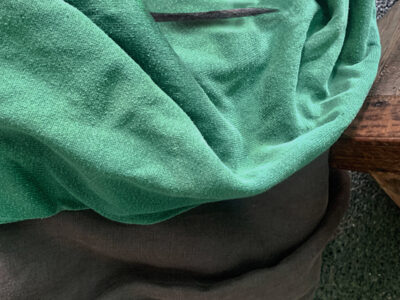Not An Allergen
Vitamin C
Ascorbic acid (what exists in nature; sodium ascorbate and calcium ascorbate are more stable synthetic salts) does not appear on published lists on common contact allergens. This is reinforced by the fact that very few allergies have been reported (see de Groot in references below), despite vitamin C being found in so many products (from foods to cosmetics and supplements).
Some foods that we associate with vitamin C like lemons, limes, and oranges are top contact allergens, but it is the limonene, terpene, and other natural chemicals in the rinds, leaves and other parts of the plant that are allergenic, not the ascorbic acid itself.
Some dissolvable or chewable supplements with vitamin C may also contain common contact allergens like preservatives and dyes. Cosmetics with vitamin C may also contain other allergens such as fragrances, dyes, essential oils, parabens, or other preservatives.
Because vitamin C is notoriously unstable, making it extremely difficult to extract and keep in supplements (vitamin pills and drinks) and skincare formulations, it is still best to get your daily dose in foods like broccoli, tomatoes, cauliflower, kale, bell peppers, and sweet potatoes.
If you have a history of sensitive skin, don’t guess: random trial and error can cause more damage. Ask your dermatologist about a patch test.
To shop our selection of hypoallergenic products, visit vmvhypoallergenics.com. Need help? Ask us in the comments section below, or for more privacy (such as when asking us to customize recommendations for you based on your patch test results) contact us by email, or drop us a private message on Facebook.
For more:
On the prevalence of skin allergies, see Skin Allergies Are More Common Than Ever and One In Four Is Allergic to Common Skin Care And Cosmetic Ingredients.
To learn more about the VH-Rating System and hypoallergenicity, click here.
Main References:
Regularly published reports on the most common allergens by the North American Contact Dermatitis Group and European Surveillance System on Contact Allergies (based on over 28,000 patch test results, combined), plus other studies. Remember, we are all individuals — just because an ingredient is not on the most common allergen lists does not mean you cannot be sensitive to it, or that it will not become an allergen. These references, being based on so many patch test results, are a good basis but it is always best to get a patch test yourself.
2. W Uter et al. The European Baseline Series in 10 European Countries, 2005/2006–Results of the European Surveillance System on Contact Allergies (ESSCA). Contact Dermatitis 61 (1), 31-38.7 2009
3. Wetter, DA et al. Results of patch testing to personal care product allergens in a standard series and a supplemental cosmetic series: An analysis of 945 patients from the Mayo Clinic Contact Dermatitis Group, 2000-2007. J Am Acad Dermatol. 2010 Nov;63(5):789-98.
4. Verallo-Rowell VM. The validated hypoallergenic cosmetics rating system: its 30-year evolution and effect on the prevalence of cosmetic reactions. Dermatitis 2011 Apr; 22(2):80-97
5. Ruby Pawankar et al. World Health Organization. White Book on Allergy 2011-2012 Executive Summary.
6. Misery L et al. Sensitive skin in the American population: prevalence, clinical data, and role of the dermatologist. Int J Dermatol. 2011 Aug;50(8):961-7.
7. Warshaw EM1, Maibach HI, Taylor JS, Sasseville D, DeKoven JG, Zirwas MJ, Fransway AF, Mathias CG, Zug KA, DeLeo VA, Fowler JF Jr, Marks JG, Pratt MD, Storrs FJ, Belsito DV. North American contact dermatitis group patch test results: 2011-2012.Dermatitis. 2015 Jan-Feb;26(1):49-59.
8. Warshaw, E et al. Allergic patch test reactions associated with cosmetics: Retrospective analysis of cross-sectional data from the North American Contact Dermatitis Group, 2001-2004. J AmAcadDermatol 2009;60:23-38.
9. Foliaki S et al. Antibiotic use in infancy and symptoms of asthma, rhinoconjunctivitis, and eczema in children 6 and 7 years old: International Study of Asthma and Allergies in Childhood Phase III. J Allergy Clin Immunol. 2009 Nov;124(5):982-9.
10. Kei EF et al. Role of the gut microbiota in defining human health. Expert Rev Anti Infect Ther. 2010 Apr; 8(4): 435–454.
11. Thavagnanam S et al. A meta-analysis of the association between Caesarean section and childhood asthma. Clin Exp Allergy. 2008;38(4):629–633.
12. Marks JG, Belsito DV, DeLeo VA, et al. North American Contact Dermatitis Group patch-test results, 1998 to 2000. Am J Contact Dermat. 2003;14(2):59-62.
13. Warshaw EM, Belsito DV, Taylor JS, et al. North American Contact Dermatitis Group patch test results: 2009 to 2010. Dermatitis. 2013;24(2):50-99.
14. Wetter DA, Yiannias JA, Prakash AV, Davis MD, Farmer SA, el-Azhary RA, et al. Results of patch testing to personal care product allergens in a standard series and a supplemental cosmetic series: an analysis of 945 patients from the Mayo Clinic Contact Dermatitis Group, 2000-2007. J Am Acad Dermatologist 2010;63:789-798
15. Swinnen I, Goossens A. Allergic contact dermatitis caused by ascorbic tetraisopalmitate. Contact Dermatitis 2011;64:241-242
16. Belhadjali H, Giordano-Labadie F, Bazex J. Contact dermatitis from vitamin C in a cosmetic anti-aging cream. Contact Dermatitis 2001;45:317
17. de Groot, A. Monographs in Contact Allergy: Non-Fragrance Allergens in Cosmetics (Parts 1 and 2). Boca Raton, FL: CRC Press; 2018.
Want more great information on contact dermatitis? Check out the American Contact Dermatitis Society, Dermnet New Zealand, and your country’s contact dermatitis association.
 Laura is our “dew”-good CEO at VMV Hypoallergenics and eldest daughter of VMV’s founding dermatologist-dermatopathologist. She has two children, Madison and Gavin, and works at VMV with her sister CC and husband Juan Pablo (Madison and Gavin frequently volunteer their “usage testing” services). In addition to saving the world’s skin, Laura is passionate about health, inclusion, cultural theory, human rights, happiness, and spreading goodness (like a great cream!)
Laura is our “dew”-good CEO at VMV Hypoallergenics and eldest daughter of VMV’s founding dermatologist-dermatopathologist. She has two children, Madison and Gavin, and works at VMV with her sister CC and husband Juan Pablo (Madison and Gavin frequently volunteer their “usage testing” services). In addition to saving the world’s skin, Laura is passionate about health, inclusion, cultural theory, human rights, happiness, and spreading goodness (like a great cream!)


